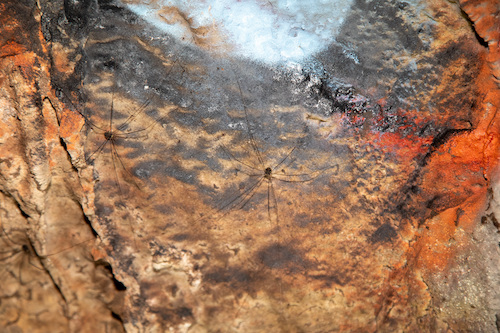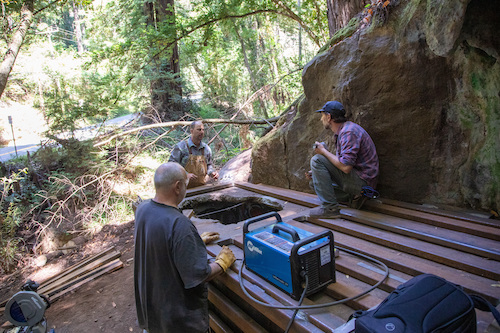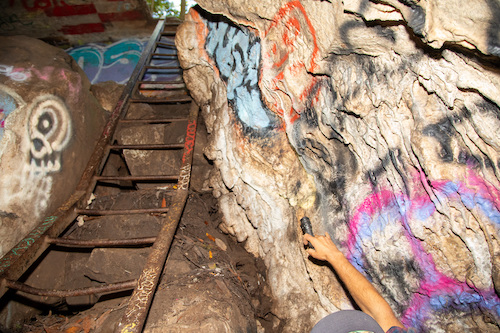Empire Cave, in the upper campus area known as Cave Gulch, likely started as a crack in a rock. Slowly, over hundreds of thousands of years, rainwater and groundwater dissolved their way through the area’s marble bedrock, turning that crack into a water-filled cavern. Geologic forces eventually pushed the whole underground network upward, above the water table, draining the water and leaving a cave in its wake.
The cave and others in the area would eventually develop unique ecosystems. Empire Cave, sometimes called Porter Cave by UC Santa Cruz students and historically also known as Cowell Cave and Santa Cruz Cave, is now believed to serve as the primary habitat of a diverse assembly of organisms, several of which are only found in caves. In total, 76 species have been found in Empire Cave since scientific explorations began in the 1950s. Of these species, at least four have been found nowhere else on Earth, including the MacKenzie's cave amphipod and an as-yet-unidentified aquatic isopod, both of which are types of tiny crustaceans. Others cannot yet be attributed to any known species and may prove, upon further study, to be new species themselves. Among other rare inhabitants of the cave are the Dolloff's cave spider and the Empire Cave pseudoscorpion.
Earlier this month, as part of a new approach to protect this unique habitat, a crew from the campus carpentry shop installed a wildlife-friendly gate across the Empire Cave entrance. Access is now limited to education, research, and the Amah Mutsun Tribal Band.
“It’s an incredibly rare habitat that supports a number of species that are at risk of extinction,” said UC Santa Cruz Campus Natural Reserve Manager Alex Jones. “We have watched as conditions in the cave have deteriorated over the decades and it’s our duty as responsible stewards to do what we can to protect these organisms and their habitat from further harm.”
Unfortunately, countless visits to the cave by visitors over the years have already damaged the habitat. Empire Cave — presumably named for its proximity to Empire Grade Road, itself named after the now long defunct Empire Mining Company — has long been a popular gathering spot. The cave saw visitors well before the campus was even built. A 2001 California Academy of Sciences report on the cave noted that the first reference to an “Empire Cave” in the area came in 1872. A study of cave usage in summer 2022 recorded 217 groups of people, presumably community members and students, visiting the cave over a 30-day period, or roughly seven groups a day. All told, 455 people entered the cave during that period. More than 20 of the visitors vandalized the exterior of the cave.
The past 150-plus years of visits have left the cave in tough shape. Stalagmites and stalactites appear to have once been prominent in the cave. All that is left now are a few rock stumps, some of them about 2 feet wide. The walls are covered with spray-painted graffiti that likely negatively impacts rare invertebrates that live on the cave’s rock walls. A recent visit revealed heaps of trash, from food wrappers to empty aluminum cans, as well as the remnants of a campfire. Names are etched into the cave walls.
Jones said he believes that most who enter the cave do not mean to harm it. He knew of the cave when he was an environmental studies student at UC Santa Cruz in the 1990s, and said he fully understands the excitement that comes from exploring new places. A concrete cap was built over the entrance in 1963, but trespassers eventually breached it, allowing unregulated entry once again.
A 2017 report from scientists affiliated with the California Academy of Sciences ranked Empire Cave No. 3 of roughly 1,300 California caves in terms of biodiversity, but noted it's also one of the state’s most abused caves, “trashed by numerous visitors over the years.” Ironically, the report also notes that the concrete cap, while well-intentioned, likely negatively impacted the cave itself, drastically reducing the cave entrance dimensions, affecting light levels, and thwarting easy access by bats and amphibians.
Jones said he’s seen a decline in some of the more visible species over the past decade. Visiting the cave earlier this month, he pointed to a group of twilight moths clustered on a graffitied wall. “This used to be covered with moths,” he said.
Steven Johnson, president of the Western Cave Conservancy, a nonprofit dedicated to protecting the natural wonder of caves in the western United States, said he was happy to hear about the gate project. “To be honest, that’s a cave that we thought was hopeless, in terms of its condition, so I’m glad there’s an impetus to give its protection another try. It’s got unique species that survive only in Santa Cruz — nowhere else on Earth. We owe it to them not to tromp them out of existence if it’s avoidable.”
The 2021 UC Santa Cruz Long Range Development Plan, approved by UC Regents, includes a mitigation measure to limit human disturbance of cave ecosystems by discouraging any activity that jeopardizes the physical integrity, condition, or scientific value of the caves on UCSC property. The construction of a wildlife-friendly gate is included as a means to reduce further cave degradation.
The hope is that the new metal gate will protect the rare and sensitive ecosystem, ensuring the survival of the creatures that live there and preventing further degradation. A new sign has been posted at the cave entrance as part of the project, noting the cave’s scientific value and why access is now restricted. It includes two QR codes; one directs visitors to a UCSC Natural Reserves webpage that explains the cave’s biodiversity, the other to the 2017 California Academy of Sciences report on California caves that includes details on Empire Cave.
“I’m sure some folks will be disappointed that they’ll no longer be able to enter the cave, but the extreme sensitivity of the habitat and rarity of its organisms make it hard to argue that Empire Cave is not worth protecting,” Jones said. “Unfortunately it’s a place that we can love to death. Excluding people from nature is often not the right way to go, but with uncontrolled access to the cave, the long-term future of its many species was looking pretty bleak.
“As we face down a global biodiversity crisis, we, as stewards of this incredible ecosystem, are taking action locally, trying to do what we can to ensure this cave and its creatures have a chance to thrive into the future."





